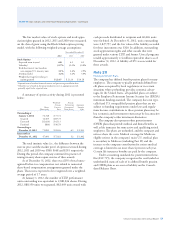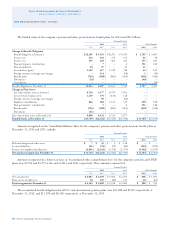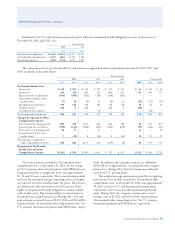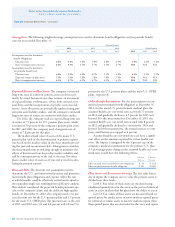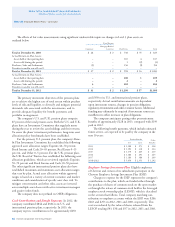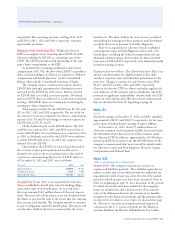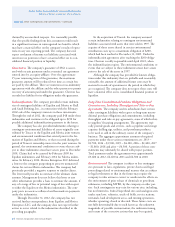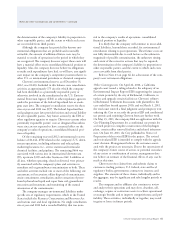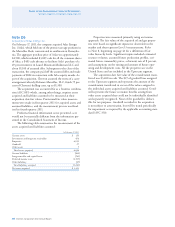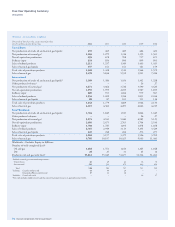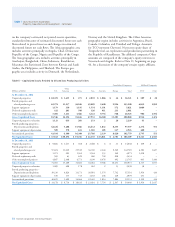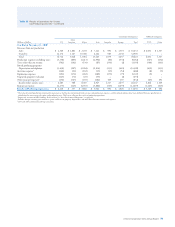Chevron 2012 Annual Report Download - page 67
Download and view the complete annual report
Please find page 67 of the 2012 Chevron annual report below. You can navigate through the pages in the report by either clicking on the pages listed below, or by using the keyword search tool below to find specific information within the annual report.
Chevron Corporation 2012 Annual Report 65
Note 22 Other Contingencies and Commitments – Continued
rial to the company’s results of operations, consolidated
nancial position or liquidity.
It is likely that the company will continue to incur addi-
tional liabilities, beyond those recorded, for environmental
remediation relating to past operations. ese future costs are
not fully determinable due to such factors as the unknown
magnitude of possible contamination, the unknown timing
and extent of the corrective actions that may be required,
the determination of the company’s liability in proportion to
other responsible parties, and the extent to which such costs
are recoverable from third parties.
Refer to Note 23 on page 66 for a discussion of the com-
pany’s asset retirement obligations.
Other Contingencies On April 26, 2010, a California
appeals court issued a ruling related to the adequacy of an
Environmental Impact Report (EIR) supporting the issuance
of certain permits by the city of Richmond, California, to
replace and upgrade certain facilities at Chevron’s renery
in Richmond. Settlement discussions with plaintis in the
case ended late fourth quarter 2010, and on March 3, 2011,
the trial court entered a nal judgment and peremptory writ
ordering the City to set aside the project EIR and conditional
use permits and enjoining Chevron from any further work.
On May 23, 2011, the company led an application with the
City Planning Department for a conditional use permit for
a revised project to complete construction of the hydrogen
plant, certain sulfur removal facilities and related infrastruc-
ture. On June 10, 2011, the City published its Notice of
Preparation of the revised EIR for the project. e revised
and recirculated EIR is intended to comply with the appeals
court decision. Management believes the outcomes associ-
ated with the project are uncertain. Due to the uncertainty of
the company’s future course of action, or potential outcomes
of any action or combination of actions, management does
not believe an estimate of the nancial eects, if any, can be
made at this time.
Chevron receives claims from and submits claims to
customers; trading partners; U.S. federal, state and local
regulatory bodies; governments; contractors; insurers; and
suppliers. e amounts of these claims, individually and in
the aggregate, may be signicant and take lengthy periods to
resolve.
e company and its aliates also continue to review
and analyze their operations and may close, abandon, sell,
exchange, acquire or restructure assets to achieve operational
or strategic benets and to improve competitiveness and prof-
itability. ese activities, individually or together, may result
in gains or losses in future periods.
the determination of the company’s liability in proportion to
other responsible parties, and the extent to which such costs
are recoverable from third parties.
Although the company has provided for known envi-
ronmental obligations that are probable and reasonably
estimable, the amount of additional future costs may be
material to results of operations in the period in which they
are recognized. e company does not expect these costs will
have a material eect on its consolidated nancial position or
liquidity. Also, the company does not believe its obligations
to make such expenditures have had, or will have, any signi-
cant impact on the company’s competitive position relative to
other U.S. or international petroleum or chemical companies.
Chevron’s environmental reserve as of December 31,
2012, was $1,403. Included in this balance were remediation
activities at approximately 175 sites for which the company
had been identied as a potentially responsible party or
otherwise involved in the remediation by the U.S. Environ-
mental Protection Agency (EPA) or other regulatory agencies
under the provisions of the federal Superfund law or analo-
gous state laws. e company’s remediation reserve for these
sites at year-end 2012 was $157. e federal Superfund law
and analogous state laws provide for joint and several liability
for all responsible parties. Any future actions by the EPA or
other regulatory agencies to require Chevron to assume other
potentially responsible parties’ costs at designated hazardous
waste sites are not expected to have a material eect on the
company’s results of operations, consolidated nancial posi-
tion or liquidity.
Of the remaining year-end 2012 environmental reserves
balance of $1,246, $782 related to the company’s U.S. down-
stream operations, including reneries and other plants,
marketing locations (i.e., service stations and terminals),
chemical facilities, and pipelines. e remaining $464 was
associated with various sites in international downstream
$93, upstream $309 and other businesses $62. Liabilities at
all sites, whether operating, closed or divested, were primar-
ily associated with the company’s plans and activities to
remediate soil or groundwater contamination or both. ese
and other activities include one or more of the following: site
assessment; soil excavation; osite disposal of contaminants;
onsite containment, remediation and/or extraction of petro-
leum hydrocarbon liquid and vapor from soil; groundwater
extraction and treatment; and monitoring of the natural
attenuation of the contaminants.
e company manages environmental liabilities under
specic sets of regulatory requirements, which in the United
States include the Resource Conservation and Recovery Act
and various state and local regulations. No single remediation
site at year-end 2012 had a recorded liability that was mate-




